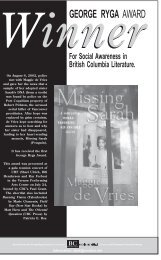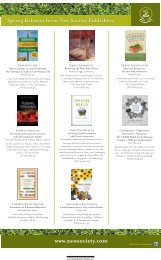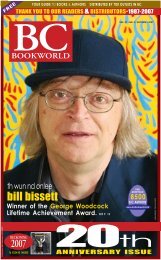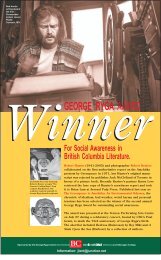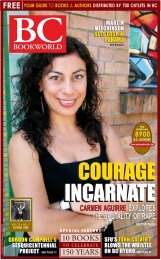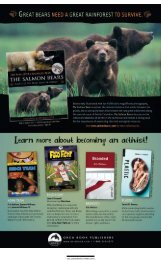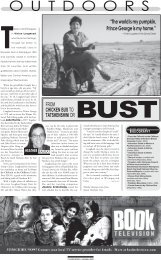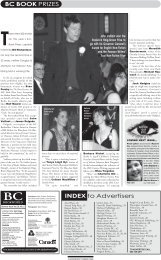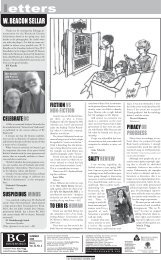Autumn 2011 Volume 25 - No 3 - BC BookWorld
Autumn 2011 Volume 25 - No 3 - BC BookWorld
Autumn 2011 Volume 25 - No 3 - BC BookWorld
Create successful ePaper yourself
Turn your PDF publications into a flip-book with our unique Google optimized e-Paper software.
LOOKOUTa forum for & about writers # 44<br />
3516 W. 13th Ave., Vancouver, <strong>BC</strong> V6R 2S3 • bookworld@telus.net<br />
TWIGG PHOTO<br />
Growing up in Vancouver,<br />
I had always<br />
wanted to<br />
make books but had no idea<br />
how I’d go about it. How<br />
would I find the authors and<br />
good manuscripts And how<br />
in hell would I finance the endeavour<br />
In 1991, I ran into a friend,<br />
Rachel Mines, who was pursuing<br />
her Masters in linguistics. She<br />
told me about her dissertation and<br />
wondered if it might be appealing<br />
to a general readership. I told her<br />
I’d give it a read. It was titled A Toilet<br />
Paper: A Treatise On Four Fundamental<br />
Words Referring to Gaseous &<br />
Solid Wastes Together with Their<br />
Point of Origin. This was a literary<br />
and scholarly work, and—most importantly—it<br />
was funny. So this odd<br />
little title became Anvil’s first “book”<br />
even though it was only forty pages<br />
and didn’t fulfil the UNESCO official<br />
definition of a “book” (i.e. having<br />
at least 48 pages).<br />
A Toilet Paper was more of a pamphlet,<br />
saddle-stitched with historical<br />
illustrations provided by the wonderful<br />
world of the Public Domain,<br />
but we managed to break even on our printing and<br />
mailing costs.<br />
Around this time Dark Horse Theatre had a call<br />
out for one-act plays to receive a staged reading at<br />
the Waterfront Theatre on Granville Island. I submitted<br />
a play I was working on, Fragments from the<br />
Big Piece, and it was selected as one of four plays to<br />
receive workshop treatment.<br />
I met another playwright in the competition,<br />
Dennis E. Bolen, who had a novel that he’d been<br />
sending around to publishers without much luck. I<br />
told him I’d have a look. I also showed Dennis<br />
subTerrain magazine; he loved it and became involved<br />
immediately. That’s how Issue #3 featured an excerpt<br />
from Stupid Crimes, his excellent novel-in-waiting.<br />
We needed a real office and found it in the ’hood<br />
at 2414 Main Street (the pie-wedge building at the<br />
intersection of Kingsway and Main). We paid $300 a<br />
month and three of us—myself, Dennis and Lawrence<br />
McCarthy—pitched in a hundred bucks<br />
each. We hung out our shingle: Anvil Press Publishers:<br />
Desktop and Graphic Design.<br />
We had to do a good deal of commercial work<br />
(posters, brochures, programs, publications) to bankroll<br />
our first trade paperback edition, Dennis’ perfect-bound<br />
novel, Stupid Crimes. The cover: an<br />
evening shot in front of Uptown Barbers (that’s me<br />
and Dennis) suggesting a drug deal or a parolee and<br />
his parole officer. All noir and urban grit (photo by<br />
J. Lawrence), the design employed black, white,<br />
and a slash of red.<br />
Thank god we didn’t think we could afford a fullcolour<br />
cover. The image was perfect for the content:<br />
a hard-drinking, hopelessly romantic, over-worked<br />
parole officer tries to guide his hapless charges toward<br />
a life without crime.<br />
We worked with our first small distributor (Marginal<br />
Distribution) and waited. <strong>No</strong>w what Would the<br />
ANVIL ISLAND<br />
Brian Kaufman describes how his Anvil Press<br />
imprint evolved into one of the country’s most<br />
enduring venues for audacious writing.<br />
Karen Green and Brian Kaufman of Anvil Press<br />
stores order more copies as the ones they had flew off<br />
the shelves Would the big cheques start rolling in<br />
Well, not quite. But Stupid Crimes did do well. It<br />
received positive reviews across the country and we<br />
even managed to land a rave in the Globe & Mail.<br />
We noticed a spike in orders and a spike in<br />
sales.<br />
An upstart crow from B.C. was making some noise.<br />
It felt good; it made us think that publishing was easy.<br />
Ha! We basked in our naïve optimism, but that<br />
wouldn’t last for long. I couldn’t have started a publishing<br />
company at a worse time (unless I was starting<br />
right now!).<br />
The recession of the early ’90s was in full swing.<br />
We published for six years before receiving our first<br />
<strong>BC</strong> Arts Council grant for Mark Leiren-<br />
Young’s Shylock. The Canada Council’s “Support<br />
for Emerging Publishers Program” didn’t yet exist (I<br />
was told later that this program came into being due<br />
to cases like Anvil—we were putting out good books<br />
but there just wasn’t any money to help.)<br />
Around the same time, the late Bruce Serafin<br />
launched the original VR (Vancouver Review) magazine,<br />
a fresh breath of wonderfully cranky air, which<br />
seemed to be in line with our own aesthetic. Bruce<br />
put me onto the work of Grant Buday, someone<br />
who Bruce described as kind of a cross between<br />
Charles Bukowski and Charles Dickens.<br />
We published his story collection, Monday Night<br />
Man that became a finalist for the City of Vancouver<br />
Book Award. We would later publish his outstanding<br />
Vancouver labour novel, White Lung, also a City of<br />
Vancouver Book Award Finalist.<br />
Anvil Press was attracting more writers and friends<br />
willing to help out. People like Isabella Legosi<br />
Mori, Angela Rhodes McIntyre, and<br />
Heidi Greco—three fine poets whose work comprised<br />
the volume Siren Tattoo: A Triptych.<br />
✍<br />
ANOTHER WRITER FROM THIS<br />
period was Bud Osborn.<br />
We published his debut collection,<br />
Lonesome Monsters, (unless<br />
you count Black Azure, a rarity<br />
printed up by a friend who<br />
worked at Coach House Books<br />
in Toronto). Bud’s work came<br />
at us like a scream from the cellar.<br />
His stories of addiction, poverty,<br />
and family violence were<br />
like raw nerve wires snapping<br />
and zapping all your senses at<br />
once.<br />
Publishing Bud would start<br />
a long-time commitment to<br />
publishing books about and by<br />
residents of the Downtown<br />
Eastside, work that dealt with<br />
the grittier aspects of our city<br />
of glass.<br />
Others that would follow in<br />
this loose “Vancouver Series”<br />
would be:<br />
Bart Campbell’s The<br />
Door Is Open (about his years<br />
spent working in a Downtown<br />
Eastside soup kitchen).<br />
Lincoln Clarkes’ Heroines,<br />
a collection of photographs<br />
that documented the<br />
plight of hundreds of<br />
marginalized and drug addicted<br />
women of the DTES<br />
from the late ’80s to the mid-1990s.<br />
Michael Barnholden’s history of Vancouver<br />
riots, Reading the Riot Act.<br />
Eve Lazarus’s At Home with History (finalist<br />
in the Vancouver Books Awards).<br />
Signs of the Times, a print and poetry collaboration<br />
between Bud Osborn and Strathcona<br />
printmaker and muralist Richard Tetrault.<br />
Gabor Gazstonyi’s A Room In the City, a collection<br />
of intimate and emotionally stirring portraits of<br />
residents of five DTES single-room occupancy hotels.<br />
✍<br />
I THINK THESE TITLES STAND TO EXEMPLIFY WHAT ANVIL<br />
came to be known as—a publisher not so much from<br />
the academy but from the street.<br />
The writers we tend to publish write out of life<br />
experience and not so much from schools of thought<br />
or theory (less dogma and more of the real meal deal).<br />
So the tales they tell tend to be more immediate, palpable,<br />
more pulsing and expectant than residing up<br />
in your head.<br />
I’m thinking of titles such as Salvage King, Ya! by<br />
Mark Anthony Jarman, Stolen by Annette<br />
Lapointe (Giller nominee) and Animal, stories by<br />
Alexandra Leggat (Trillium Prize Finalist)—<br />
and many, many others that I can’t list here.<br />
Collectively, they make me proud to have been<br />
given the privilege to find a vocation in the world of<br />
literary publishing.<br />
✍<br />
[The Anvil Press imprint was preceded by Brian<br />
Kaufman’s subTerrain magazine. Issue #1 of<br />
subTerrain appeared twenty-three years ago this August.<br />
The early history of subTerrain can be found<br />
under Brian Kaufman’s entry on abcbookworld.com]<br />
This is the seventh installment in <strong>BC</strong> <strong>BookWorld</strong>’s<br />
ongoing series on the history of B.C. publishing.<br />
19 <strong>BC</strong> BOOKWORLD • LOOKOUT • AUTUMN • <strong>2011</strong>



